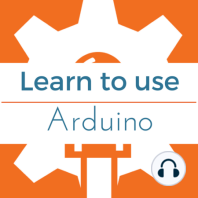21 min listen

How to Use and Understand the Arduino Reference
How to Use and Understand the Arduino Reference
ratings:
Length:
13 minutes
Released:
Apr 12, 2017
Format:
Podcast episode
Description
So you just opened up your fancy new gadget - maybe an awesome DSLR camera, or the newest gaming system, or maybe a new Blu-ray player. As you gladly tear away the packaging - you notice a small book that feels like it was printed on 4th generation recycled newspaper - it’s the instruction manual. As you skim the pages you realize it was first written in Japanese, translated to Chinese by an Australian ventriloquist and then an intern in California used Google Translate to finish the job for your native tongue. So you toss the instruction manual and just plug the gadget in. Good for you - especially since it appears as everything is working just fine. Until.. ...something isn’t working just fine. Maybe you can’t navigate the menu options to find a setting that was advertised on the box, or maybe the functionality you thought your gadget has does not appear to be working no matter how correctly it seems you are pressing the buttons. This tutorial is going to focus on the Arduino instruction manual, known more commonly as the “Arduino Reference” or the “Arduino Documentation”. It is an important and useful aspect of learning to use Arduino - it will be your best friend in times of bewilderment, brain lapses and fits of rage. I know that instruction manuals get a bad wrap - but don't fret - the Arduino Reference is awesome! To be honest what really keeps us away from the documentation is our fears. That’s right - the reference pages can be a bit intimidating when you are just starting out. They use a lot of technical jargon, are loaded with funky acronyms and filled with rabbit holes. Nobody uses the stuff anyway...right? ( Not right - that was a joke! ) This Tutorial Will Cover: What is the Arduino Reference? The Anatomy of an Arduino Reference Page. Why You Should Be Using the Arduino Reference More. How to use brain waves to trick your cat into eating less. Have you ever read a book and come upon a word you didn’t understand? Sometimes you can infer the meaning from it’s context, but what about when no such context exists? Likely, you used a search engine to find the definition. The definition told you what the word meant, whether is was a verb or adjective (or both), it gave some examples of how to use the word, and maybe even the etymology. The Arduino Reference is the same thing. It is the “dictionary” for all the structures, variables and functions that you can use when programming a sketch. It tells you the description, the parameters it uses, the syntax (how it is written), and even gives a bunch of examples on how to use it. So let’s jump into an Arduino Reference page and dig into what we can learn. The Anatomy of an Arduino Reference Page So let’s navigate to a reference page to start our journey. You can find the index of all the Arduino Reference pages on the Arduino Website: http://arduino.cc/en/Reference/HomePage Or - if you are offline - don’t worry, your Arduino IDE comes with an html copy of all the pages. You can get to it through the Arduino IDE: Help > Reference You will note at the top of the Reference Index page, there are three columns; Structure, Variables, Functions. This is the first level of organization in the reference. So if you are looking for a variable, you know which column to start looking in. Each of the hyperlinked items on this index page will take you to the individual entries reference page. What’s great about the individual reference pages is that they are organized in a similiar manner from one to the next, so you should know what to expect. They are also terse, so don’t think you are going to have to scour through someones dissertation. Each page has some major headings. We will walk through each of the main ones, and then talk about some less common ones. Description: All entries will have a description. Pretty straightforward - this is going to be a simple explanation of what the item does. It usually uses language that is basic. Syntax: Most all entries have a “
Released:
Apr 12, 2017
Format:
Podcast episode
Titles in the series (61)
Fade an LED with Arduino: Learn Programming and Electronics with Arduino by Learn Programming and Electronics with Arduino